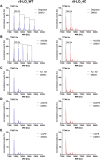Unlocking the potential: unveiling tyrphostins with Michael-reactive cyanoacrylate motif as promising inhibitors of human 5-lipoxygenase
- PMID: 39347835
- PMCID: PMC11582101
- DOI: 10.1007/s00424-024-03019-7
Unlocking the potential: unveiling tyrphostins with Michael-reactive cyanoacrylate motif as promising inhibitors of human 5-lipoxygenase
Abstract
Human 5-lipoxygenase (5-LO) is the key enzyme in the biosynthesis of leukotrienes, mediators of the innate immune system that also play an important role in inflammatory diseases and cancer. In this study, we present compounds, containing a Michael-reactive cyanoacrylate moiety as potent inhibitors of 5-LO. Representatives of the tyrosine kinase inhibitor family called tyrphostins, structurally related to known 5-LO inhibitors, were screened for their 5-LO inhibitory properties using recombinant human 5-LO, intact human PMNL (polymorphonuclear leukocytes), and PMNL homogenates. Their mode of action was characterized by the addition of glutathione, using a fourfold cysteine 5-LO mutant and mass spectrometry analysis. SAR studies revealed several members of the tyrphostin family containing a Michael-reactive cyanoacrylate to efficiently inhibit 5-LO. We identified degrasyn (IC50 0.11 µM), tyrphostin A9 (IC50 0.8 µM), AG879 (IC50 78 nM), and AG556 (IC50 64 nM) as potent 5-LO inhibitors. Mass spectrometry analysis revealed that degrasyn and AG556 covalently bound to up to four cysteines, including C416 and/or C418 which surround the substrate entry site. Furthermore, the 5-LO inhibitory effect of degrasyn was remarkably impaired by the addition of glutathione or by the mutation of cysteines to serines at the surface of 5-LO. We successfully identified several tyrphostins as potent inhibitors of human 5-LO. Degrasyn and AG556 were able to covalently bind to 5-LO via their cyanoacrylate moiety. This provides a promising mechanism for targeting 5-LO by Michael acceptors, leading to new therapeutic opportunities in the field of inflammation and cancer.
Keywords: 5-Lipoxygenase; Inflammation; Leukotrienes; Michael acceptors; Tyrphostin.
© 2024. The Author(s).
Conflict of interest statement
Declarations. Competing Interests: The authors declare no competing interests.
Figures




Similar articles
-
Michael acceptor containing drugs are a novel class of 5-lipoxygenase inhibitor targeting the surface cysteines C416 and C418.Biochem Pharmacol. 2017 Feb 1;125:55-74. doi: 10.1016/j.bcp.2016.11.004. Epub 2016 Nov 4. Biochem Pharmacol. 2017. PMID: 27823964
-
The molecular mechanism of the inhibition by licofelone of the biosynthesis of 5-lipoxygenase products.Br J Pharmacol. 2007 Oct;152(4):471-80. doi: 10.1038/sj.bjp.0707416. Epub 2007 Aug 20. Br J Pharmacol. 2007. PMID: 17704828 Free PMC article.
-
Molecular pharmacological profile of the nonredox-type 5-lipoxygenase inhibitor CJ-13,610.Br J Pharmacol. 2004 Jul;142(5):861-8. doi: 10.1038/sj.bjp.0705860. Epub 2004 Jun 14. Br J Pharmacol. 2004. PMID: 15197110 Free PMC article.
-
Lipoxygenase Inhibitors as Cancer Chemopreventives: Discovery, Recent Developments and Future Perspectives.Curr Med Chem. 2021;28(6):1143-1175. doi: 10.2174/0929867326666191210104820. Curr Med Chem. 2021. PMID: 31820690 Review.
-
Azelastine--a novel in vivo inhibitor of leukotriene biosynthesis: a possible mechanism of action: a mini review.J Asthma. 1995;32(3):227-34. doi: 10.3109/02770909509089512. J Asthma. 1995. PMID: 7759463 Review.
Cited by
-
Lipid signaling: facets of a versatile cell communication strategy in health and disease.Pflugers Arch. 2024 Dec;476(12):1777-1778. doi: 10.1007/s00424-024-03034-8. Epub 2024 Nov 11. Pflugers Arch. 2024. PMID: 39527143 Free PMC article. No abstract available.
References
-
- Awwad K, Steinbrink SD, Frömel T, Lill N, Isaak J, Häfner A-K, Roos J, Hofmann B, Heide H, Geisslinger G, Steinhilber D, Freeman BA, Maier TJ, Fleming I (2014) Electrophilic fatty acid species inhibit 5-lipoxygenase and attenuate sepsis-induced pulmonary inflammation. Antioxid Redox Signal 20:2667–2680. 10.1089/ars.2013.5473 - PMC - PubMed
MeSH terms
Substances
Grants and funding
LinkOut - more resources
Full Text Sources
Miscellaneous

